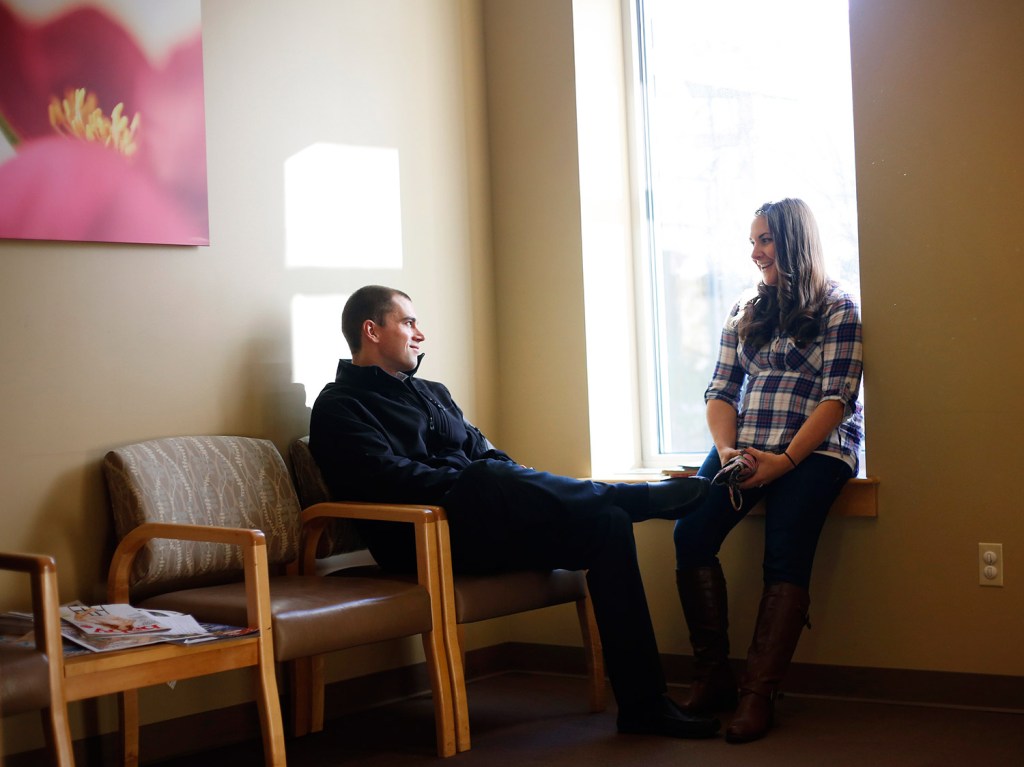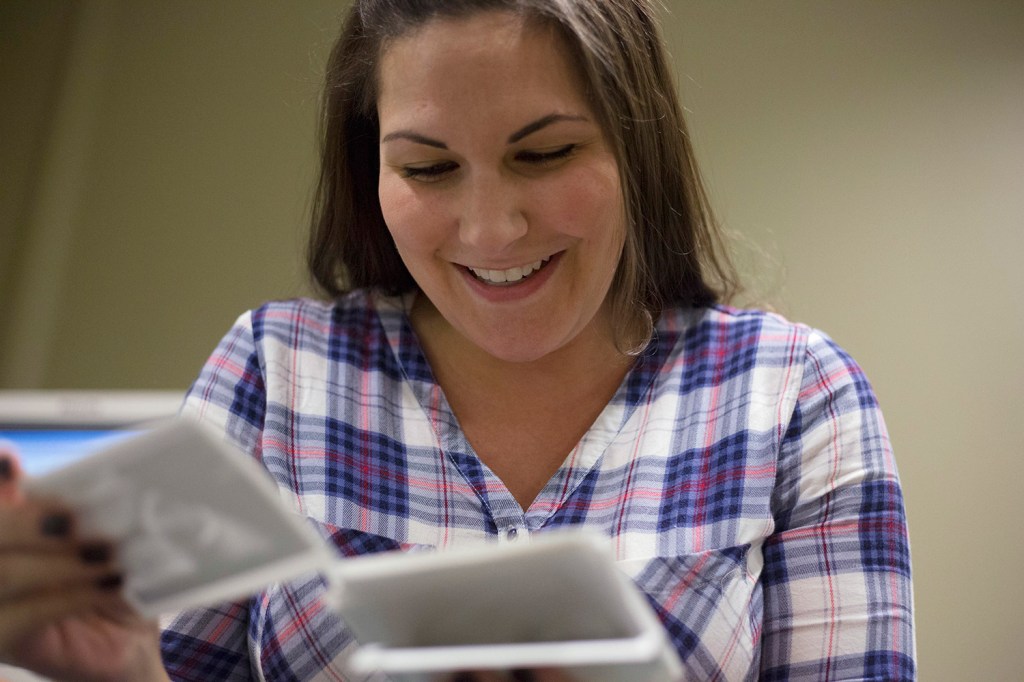Last time, Dave and Marie Gilligan were convinced it was a boy.
Everyone they knew who had used in vitro fertilization had a boy, and they had read that it was statistically more likely.
At her 20-week appointment, when they found out they were having a girl, Marie Gilligan didn’t believe it.
“You need to prove it,” she remembered telling the ultrasound tech.
As her husband pointed out, that wasn’t hard.
That surprise, however, wouldn’t compare to finding out in July, when baby Carly was 11 months old, that without any medical intervention, she was pregnant again.
 After all the drugs, surgeries and injections it took to get pregnant with Carly, it seemed impossible.
After all the drugs, surgeries and injections it took to get pregnant with Carly, it seemed impossible.
“Someone’s playing a joke on us,” she said she thought. “In my mind, I didn’t think it would ever happen.”
The first 20 weeks of this pregnancy were much different than her last one – less nausea, more heartburn – leading her to a natural conclusion.
“I’m convinced it’s a boy,” she said a little over a week ago, “convinced it’s a boy.”
Her husband, who was sure last time they were having twins, wasn’t going to bother guessing.
He was fine with waiting until their scheduled ultrasound, when they would find out.
Marie Gilligan, 31, grew up in Windham as one of six children with an older and younger sister who are each less than two years apart from her. Her mother is one of nine, and Gilligan couldn’t tell you how many cousins she has without counting.
Dave Gilligan’s family in South Burlington, Vermont, is nowhere near as big or as boisterous. Gilligan, 33, has one brother who is six years younger – an age gap, the Gilligans agreed, that was bigger than what they wanted for their children. What they couldn’t agree on was a number.
“I’ve always wanted four, always,” she said.
Her husband was willing to compromise with three.
But, when they starting trying, they were faced with a much bigger dilemma – that they might not be able to have any.
The Gilligans, who met as students at the University of Vermont, had moved to Maine in 2011 to raise a family. They had been living outside of Boston, where he got an MBA and began a career in finance. She got a job at an accounting firm that has kept her on, working remotely.
After renting in Scarborough, they found a house to buy in Westbrook, went on a last hurrah to Mexico, then decided it was time.
“They always say give yourself a year to try,” Marie Gilligan said, but months after going off birth control, she wasn’t even getting her period, let alone pregnant.
After seeing her doctor, Gilligan was diagnosed with polycystic ovary syndrome and put on drugs to get her to ovulate, but five months later she still wasn’t pregnant.
Over the next year, she had two surgeries, tried intrauterine insemination and, finally, started in vitro fertilization.
Without coverage from insurance, every procedure was cash from their pockets and it was hard to know how long to keep trying if, in the end, it would be all for nothing.
“You don’t want to put your financial security at risk, but at the same time, you want this thing so bad,” Dave Gilligan said.
It took two years and three attempts at IVF before finding out it had all been worth it.
Six weeks after Carly was born, Gilligan’s doctor asked what she was going to do about birth control – a ridiculous question, she thought. Not long after, however, she started getting her period and her cycle was actually normal for the first time in her life. Still, she didn’t see the need to worry about getting pregnant again too quickly.
In June, she told her doctor she was thinking about trying again – they wanted their children to be close in age – so she had an ultrasound done to check on her uterus and everything looked good.
They figured they’d give it six months before going back to the fertility clinic where she still had frozen eggs.
But one day in July, as she was packing to go away to see family in northern Maine for the weekend, she realized she should have gotten her period.
Not one to wait, she got out a pregnancy test she had in a drawer, just to see.
“I was like, no way, there’s no way,” she said she told herself.
After taking the test, she put it down on the sink, then turned to start the shower. When she turned back, it was blinking with the word “pregnant” on the digital display.
“I still don’t believe it,” she said.
They’ve tried to tell Carly what’s happening, but she’s too young to understand.
“When I pull my shirt up, she just wants to play with my belly-button,” Marie Gilligan said.
But they’ve taught her the words “baby” and “brother” and “sister.”
She’s much better at saying “sister,” which would be one of the benefits of having a girl. Not to mention all the clothes sitting in their basement that they wouldn’t have to buy.
Dave Gilligan would like to have a boy at some point, but he could see how another girl would be good for Carly.
“I think it would be cool for them to grow up as sisters that close in age,” like his wife did, he said.
But, as of minutes before the appointment last week, Marie Gilligan was sure that wouldn’t be the case.
“I’m convinced it’s a boy, time and time again,” she said, sitting on a windowsill in a waiting area at Coastal Women’s Healthcare on Route 1 in Scarborough.
The couple had met there, him coming from work in Portland and her from their house in Westbrook, where her sister was watching Carly.
They chatted in hushed voices as they waited in the room, where the sunlight cast soft yellow shapes on the floor and walls.
“Marie?” said a woman in a white lab coat who appeared from around the corner. The couple followed her back.
The woman was Connie Bennett, Gilligan’s favorite sonographer from her years spent at the health center.
After an internal examination, Gilligan lifted her shirt for the ultrasound, watching a screen on the wall in front of her as Bennett pointed out the baby’s body parts.
“Look at that little nose!” Marie Gilligan said, pointing from her reclined chair.
As Bennett rolled the probe around her belly, Gilligan and her husband, sitting next to her, watched intently as gray and black blobs floated around the screen, occasionally in the shape of a foot or a mouth.
Bennett already knew the gender from the first part of the exam, but Gilligan wanted to guess for herself from the ultrasound image. Bennett made the chair tip back to get a better angle.
“They don’t pose, you have to chase after them,” she said.
At first it looked like it must be a boy, but that was just the umbilical cord, Bennett said.
She rolled the probe around some more. “This baby’s running away from me,” she said.
Gilligan was done waiting.
“It’s a boy,” she said. Bennett was silent.
“It’s a girl,” she guessed again. Bennett smiled.
Gilligan looked back up on the screen and recognized a shape she’d seen on the ultrasound for Carly and her two nieces.
“It’s a girl!” she screamed and covered her smiling face with her hands clasped together. “Oh my God, I’m so happy right now.”
She couldn’t stop saying it: “It’s a girl. It’s a girl.”
Her husband leaned over from his chair and gave her a kiss.
“Oh my God, it’s a girl,” she said. “I’m so glad I was wrong.”
Send questions/comments to the editors.







